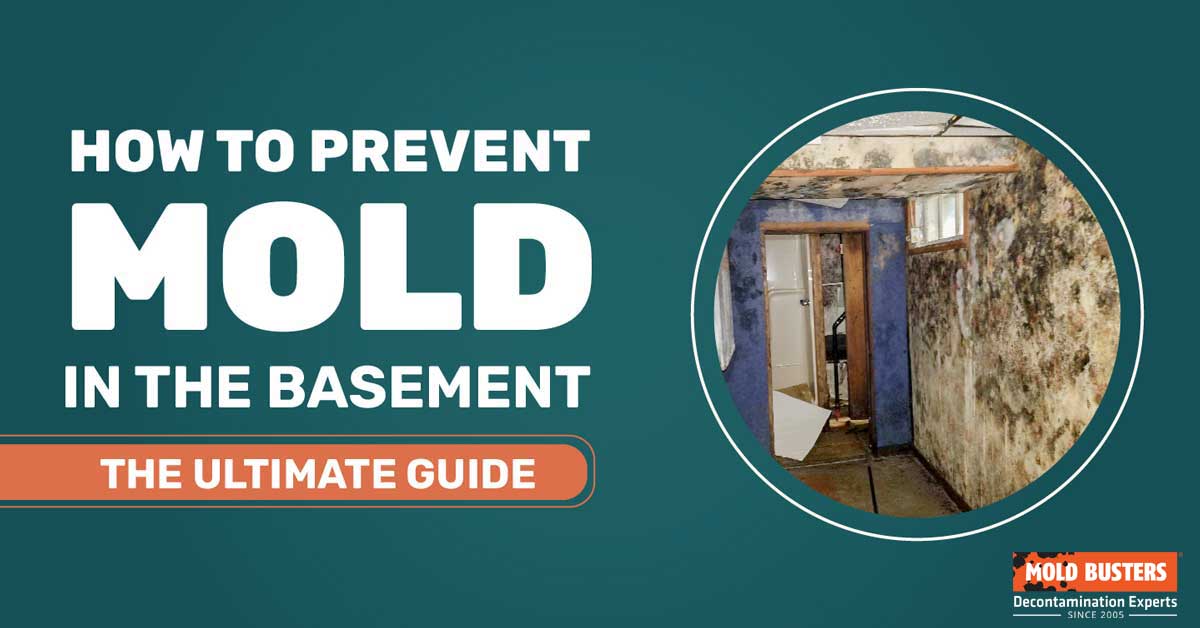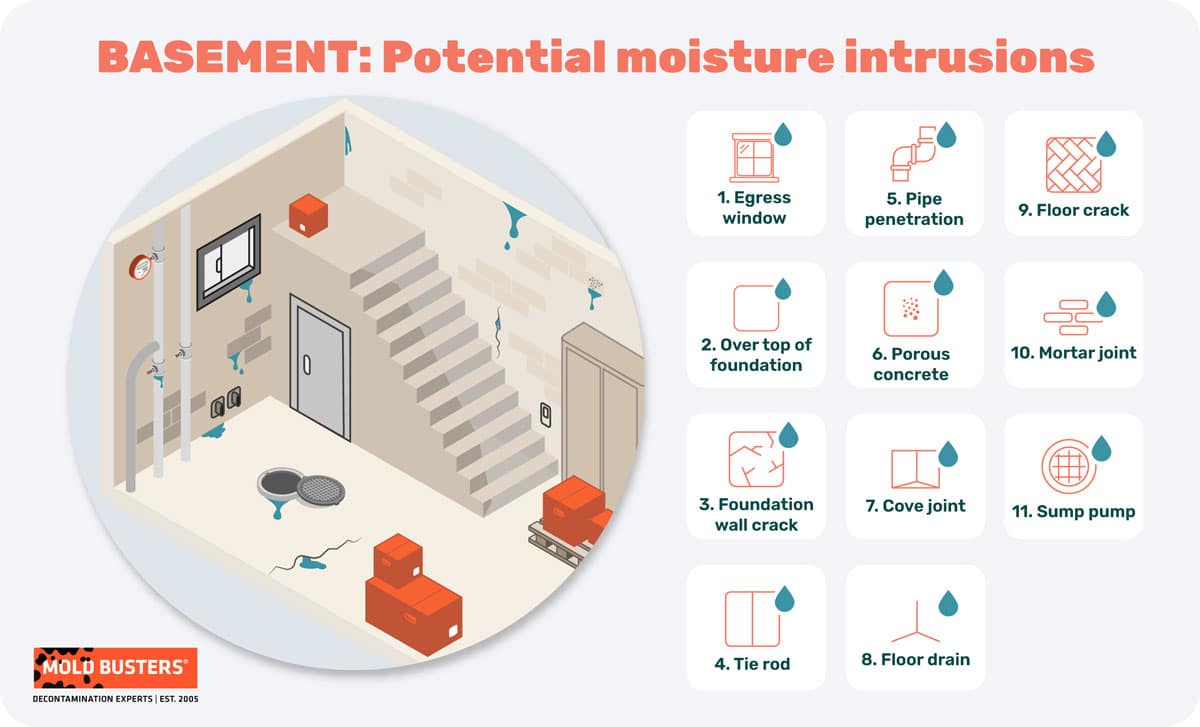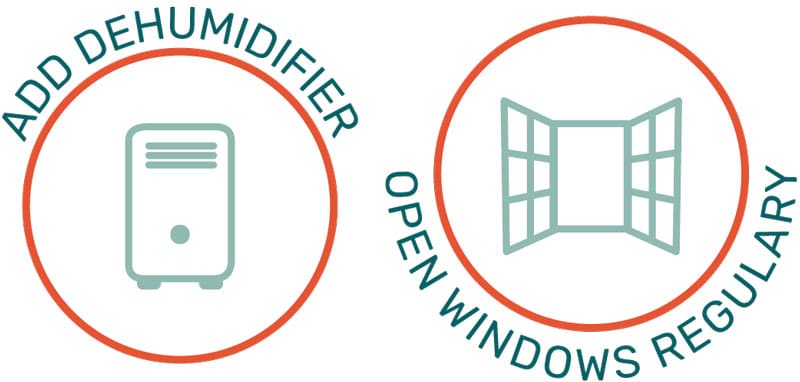How to Prevent Mold in the Basement
Mold can grow in any place with sufficient sources of moisture, organic feeding material and oxygen, making the basement its little heaven. Even if the basement seems dry, it may already be affected by mold and mildew because the fungi could be growing behind walls, underneath furniture or in carpets. This is highly possible if there has been any type of flooding or water damage in the past.
The problem with basement mold is that some mold species can be highly toxic, making living in the basement unhealthy (e.g. it is not rare for people to turn this empty space into a living room or kitchen). This means that all those allergy symptoms you feel may actually be signs of a mold invasion in your home rather than seasonal allergies.

Since basement mold is often a result of excess moisture, whether it comes from leaky foundations, condensation or even daily activities, such as cooking or drying clothes, it is very important to learn how to prevent mold in the basement from growing in the first place.
If you’ve already performed a thorough basement check and are suspicious of light or dark spots that you’ve seen, grab your phone and call professional mold experts to test for mold. Only then will you know if you need to start with mold prevention or with mold remediation.
If you’re in the Montreal or Ottawa area, we offer comprehensive mold inspection services, including mold inspection in Montreal and mold inspection and testing in Ottawa.
Common causes of mold in the basement
As mentioned above, the main cause of mold in the basement is excess moisture, which is not a rare situation in a basement. Whether that moisture comes from the outside or from the inside, it is very important to get to the root of the problem in order to deal with it and prevent any further complications (including mold).
So, where does the moisture, or water in a basement come from? Let’s dig deeper.
There are two main sources of water in basements:
- An outside moisture source – rain, groundwater, floods.
- An inside moisture source – a high level of humidity and different activities such as drying clothes.
Basements are “below grade” spaces in your home, which means that they are prone to water seeping in from the foundation walls, and window wells. Since these are the lowest parts of the home, gravity dictates that if water is present, it will flow towards the lowest area (i.e. basement) to settle.
Two frequent causes of water in basements are rain and floods. Without proper grading, gutters and downspouts, rain often flows into the basement creating excess moisture for mold to thrive in. Flooding caused by heavy rains or rivers, provides the right environment for mold growth.
When it comes to sources of moisture inside, we can talk about various causes, from ineffective insulation to excess steam that evaporates and raises the level of humidity (often a result of cooking, showering and even breathing). A high level of humidity and condensation creates the perfect conditions for both mold and mildew to spread in your basement.
Now that you are aware of the causes, you are ready to take the measures needed to prevent mold in the basement. While some steps may involve an initial investment, down the road they will save both your health and your budget.

Did you know?
Only 8% of basements we have tested didn’t have presence of mold?! Find out more exciting mold stats and facts inside our mold statistics page.
Creating a mold-resistant basement
You may feel like a party breaker now, but better to be safe than sorry. The longer your home stays mold free, the less you’ll have to worry about proper cleaning and returning mold.
Dealing with outdoor causes of mold
Since there are two main causes of mold (indoor and outdoor moisture), we are going to take the same approach to mold prevention. Let’s dig deeper into outdoor moisture causes and what you can do to prevent moisture inside your basement.
First of all, you should be aware of rains and floods as they are a direct source of water. Following the flow path of rainwater or the access part of flood will give you enough information to start with.
Pay attention to where the rainwater flows after it falls on your roof. If the ground surrounding your home is on the same level as your home or higher, it is very likely that rainwater is going to get into your basement. Talk to your contractor to have the outside ground slope away from your home or heap soil onto the ground against your home.
Rain can cause a problem without even touching the ground. The windows on your home may be a problem too. Inspect your windows and check window wells for signs of insulation problems or potential build-up issues.
Additionally, do not forget to clean the gutter to ensure proper water flow. Ensure that all downspouts extend far away from the home, especially if the grading is not optimal. That way you will ensure that rainwater flows away from your home, not into it.
Another outdoor cause of excess moisture, although not a frequent one, is flooding. It’s almost impossible to prevent floodwater from coming into the basement but it is crucial to act the minute it happens, in order to prevent mold from growing.
If your basement was flooded, take out everything (including furniture, appliances, carpets, etc) to dry in fresh air. Leave it out as long as needed. Open all basement windows (if you have them) to ensure that fresh air is coming into your basement, which is important for drying the walls. To speed up the drying process you can set up special machines which are designed to suck the moisture from the walls.
Our mold removal services are available in Montreal and Ottawa, and we also offer virtual inspections for your convenience.
If mold forms, usually when moisture dries, it will dry out too. But in case that mold remains, do not attempt to clean it with bleach or any other solution. Grab your phone and call professionals to inspect it the proper way to ensure you are mold free. They will also instruct you on how to prevent mold from growing back.
Dealing with indoor causes of mold
Monitoring humidity levels
To prevent mold from growing, you will need to cut its most important growth source – moisture. If all the outside moisture causes are fixed, and you are sure that no rainwater will leak in (you can also prevent floods in your basement), you should pay attention to the level of humidity. It is the number one inside cause of mold.
The main problem causing humidity in the basement is improper air flow. Windows are rarely open and fresh air doesn’t circulate. Adding air ventilators is therefore a must. In case you rarely open windows, you should change that habit immediately.
Keep an eye on your humidity levels from day one. If the level of humidity starts dropping, keep your windows open as much as the weather allows. But, if you do notice any changes, or you live in a highly humid climate, install dehumidifiers in your basement.
Insulate your walls, basement pipes and windows
Do not give mold reasons to grow – check every pipe for leaks and insulate them to prevent condensation due to the difference in air and pipe temperature. As soon as you notice drops of water on the pipes, ensure that they are properly changed and sealed. Use pipe sleeves, fiberglass, or other insulation materials to wrap the pipes, or cover your windows to prevent condensation during winter.
Research “dew point”, as it is a big cause of indoor mold, especially in basements. Ineffective insulation can cause dew point/condensation issues behind walls, malfunctioning sump pumps, water tank corrosion and inadequate basement underpadding (for floors/carpets).
Dry your clothes outside as much as possible
Basements are often turned into laundry rooms for drying clothes. In case you use your basement for drying clothes, ensure that humidity is properly controlled in order to prevent an increase in the overall humidity level. You can do this either by opening doors/turning on air ventilators, or by installing dehumidifiers to help the process.
The best way to prevent mold caused by drying clothes in the basement is to simply dry everything outside for as long as the weather allows it.
Avoid overloading your basement
Both an organic food source and moisture are important for mold to grow. That’s why it’s very important to cut the food source, along with lowering the humidity level in your basement. There is no better food for mold than the things you keep in your basement such as clothes, books, carpets, food and even the cardboard boxes in which you store all of those things.
Try eliminating everything that you don’t need and avoid overstuffing your basement at all costs. Air must be able to flow and it cannot do so if every inch of your basement is covered. If you must use your basement for storage, and you are worried about mold, ensure that everything is properly dried and moved away from the walls. If there is a leak or a flood, take out everything that may have been in touch with water, dry it well and then put it back.
Keep plants out of the basement
If your basement is also your living room, there is a chance you have plants inside it to make it more cozy. Don’t forget that plants are the perfect source of food for mold. Mold loves to feed on leaves and soil, so those are the places where you can find it often. The best solution is to limit the number of plants in your basement or eliminate them completely if possible.
In case you want to keep your plants there as part of your room decoration, ensure that they are mold free. Check their soil regularly and change it if you notice the first signs of mold or mildew. You can also use a special anti-fungal treatment for plants to prevent mold from growing. Do not overwater your plants. Find out how much water they need to stay healthy and stick to that amount. And, while you are checking your plants, check their leaves as well to ensure that there is no unusual discoloration, as it may be a sign of mildew.
In case you have already noticed some dark spots and you are not sure if it is mildew or mold, grab your phone and call professionals to take care of it. Don’t forget that it’s not mold until tested and that mold itself has to be treated with professional solutions to prevent it from coming back.
DIY tips for preventing mold in the basement
The experts at Mold Busters love to share what they’ve learned over their years preventing, inspecting for and removing mold. The following are some trusty tips that will help you prevent mold in your basement:
- Never allow water to accumulate near the basement. Make sure that the ground outside your home slopes away.
- Avoid having carpets in your basement.
- Keep condensation in your basement to a minimum. To do this, wrap cold surfaces like basement pipes with insulation. To make windows air tight, use a sealant around them. You can also increase the temperature in your basement.
- Humidity, which is the main cause of mold growth, should be kept as low as possible in your basement—preferably, below 60 per cent. Use a hygrometer to take regular measurements of the relative humidity in your basement. Installing a dehumidifier is also a good idea. Control dampness by promoting air circulation in your basement. This can be done by keeping the basement windows open or by opening the doors leading to the basement.
- Running a fan for one to two hours daily in the basement is also helpful. This promotes air circulation, replacing humid air with fresh air. Installing an exhaust fan in your basement is also a good idea. For ventilation purposes, Mold Busters recommends the E-Z Breathe ventilation system, the latest technology that has revolutionized the ventilation industry.
- To avoid wet floors and standing water in your basement, install a sump pump and a perimeter drain.
- Never dry wet clothes in the basement. Also never vent such appliances such as dryers, stoves, heaters, and air conditioners inside the basement. Rather, exhaust them to the outside.
- Every spring when the snow melts, water seeps into basements through cracks in the foundation. Fix problems (that often remain unnoticed) such as leaking foundation cracks, pipe leakages, leaking basement walls, sewer backups, and spills as soon as possible to avoid water intrusion in the basement. Cracks in walls or floors can be sealed with a sealant or waterproof coating. It is recommended to use ceramic tile set with waterproofing compound for basement floors. Using hydraulic cement as the tile grout is also helpful.
- Keep the basement clean and free of clutter. Discard any badly damaged or extra materials stored in basement. This improves air circulation and ventilation. Also clean your basement regularly. Don’t allow dust to settle there, as dust attracts mold. Consider getting a HEPA vacuum to vacuum your basement.
- Avoid wood flooring in your basement.
- Never store wooden materials, fabrics, paper, books or any materials that provide food for mold in your basement. If you do have such items, store them in plastic tubs.
- Never grow plants in your basement as they provide good food for mold and mildew.
However, if you suspect there’s mold, the best thing you can do is to get your basement inspected professionally.
For professional mold inspection and mold testing, you can rely on our experienced team in Montreal and Ottawa. We also provide air quality testing in Ottawa and Montreal to ensure a healthy environment in your home.
A thorough and professional mold inspection can save you from big structural damage and costly repairs in the future.

Get Special Gift: Industry-Standard Mold Removal Guidelines
Download the industry-standard guidelines that Mold Busters use in their own mold removal services, including news, tips and special offers:
Published: August 21, 2018 Updated: August 23, 2023

Written by:
John Ward
Account Executive
Mold Busters
Fact checked by:
Michael Golubev
CEO
Mold Busters




